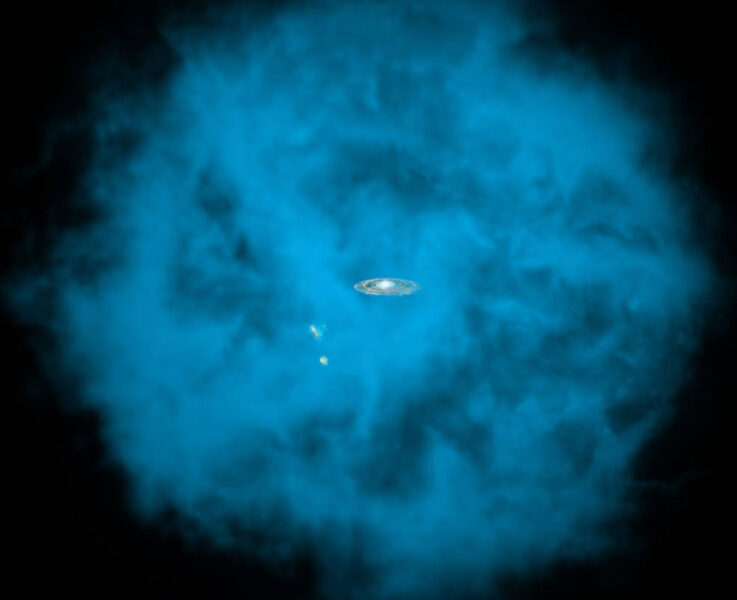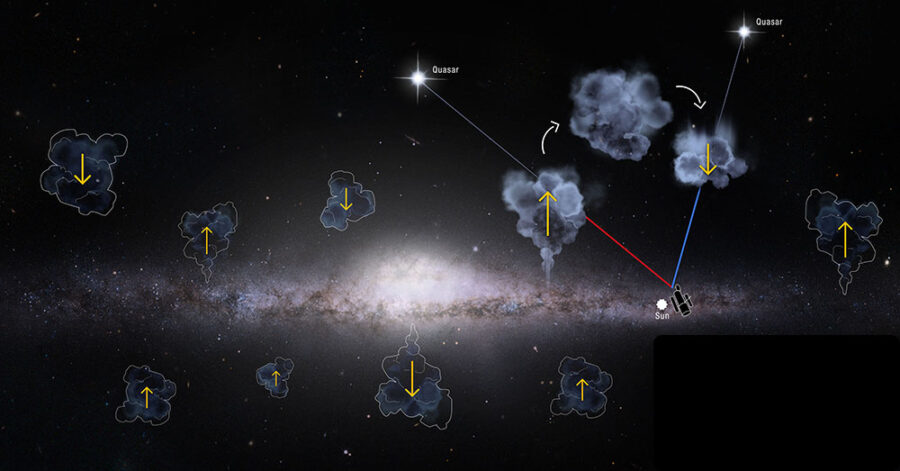New analysis shows the best view of the Milky Way halo to date, providing a window into our galaxy’s future star formation.
Think our galaxy is all in the stars? Think again. Next time you look up to see the Milky Way, remind yourself that you’re only seeing a very, very small part of the galaxy. Never mind dark matter — even normal matter is only half contained in stars and planets. The rest is in a thin, gaseous halo that surrounds our galaxy, extending far beyond the spiral-shaped stellar disk.

NASA / CXC / M.Weiss / Ohio State / A. Gupta et al.
While these gases are difficult to observe directly, they’re what sustains our galaxy over the eons, providing material for future stars and planets. Now, a new analysis of decade-old data is providing the most sensitive view to date of the Milky Way halo, to appear in the Astrophysical Journal (preprint available here).
David French and Andrew Fox (both at Space Telescope Science Institute) and their colleagues used data from the Far Ultraviolet Spectroscopic Explorer (FUSE), a space observatory that ended its mission back in 2007. The researchers examined 25 quasars, supermassive black holes whose feeding habits make them beacons, their light shining across billions of light-years and, importantly, passing through our galaxy’s halo on the way to Earth. Spread-out hydrogen atoms absorb quasar photons at specific wavelengths of light. This chemical fingerprint enables astronomers to calculate just how many atoms there are and where they’re going.
“Our survey has uncovered neutral hydrogen in the Galactic halo that is 10 billion times less dense than the best vacuums ever achieved on Earth,” Fox says, “and 1,000 times less dense than seen in the most sensitive previous observations.”
Because the study focuses on neutral hydrogen, the researchers are by definition focusing on the cooler part of the halo. There’s also lots of warm and hot gas out there, but it’s the cooler parts that condense like raindrops out of a cloud and fall onto our galaxy, providing star-formation fuel. The gas can go the other way, too; supernovae or stars’ intense radiation may also drive this fuel out of the galaxy.

NASA / ESA / D. Player (STScI)
In examining the lines of sight toward 25 quasars, French and colleagues measured 152 individual bits of gas, some of them flowing inward and some away from our galaxy. Most of these are cool gas clouds, some of them traveling more than 220,000 mph (100 km/s). And the majority of the clouds would have been invisible to previous observations.
These results have put the study of our own galaxy’s halo on the same footing as studies of other galaxies, whose halos we can better observe because we’re looking in from the outside rather than from inside out. “This detailed analysis of hydrogen gas in our galaxy lays the foundation for comparative studies to provide new insight into the processes that fuel modern galaxies.,” says J. Xavier Prochaska (University of California, Santa Cruz), who was not involved in the study.
By examining the clouds’ speeds, the researchers determine that more gas is flowing into our galaxy than out of it, with a net addition of half the Sun’s mass per year.
That seems like good news for prospective star formation in the Milky Way. It’s still a bit too soon to tell what the future holds for our galaxy, though. By its nature, this study focuses on cool, neutral hydrogen gas, and there’s a lot more to the halo than that. French's team acknowledges that more work is needed to understand the full picture of our galaxy and all its parts.
 1
1
Comments
Lariliss
October 1, 2021 at 9:57 am
We can see as deep as our observation facilities can show us. As the technology goes further, we can get more data.
This evidence makes a positive view of the future. The famous observance and image of the black hole in M87, halo studies.
The Milky Way Galaxy may be more puzzling than distant ones, as we observe it from inside. Still the recent progress on its observations to bring more knowledge is really encouraging.
Thank you.
You must be logged in to post a comment.
You must be logged in to post a comment.